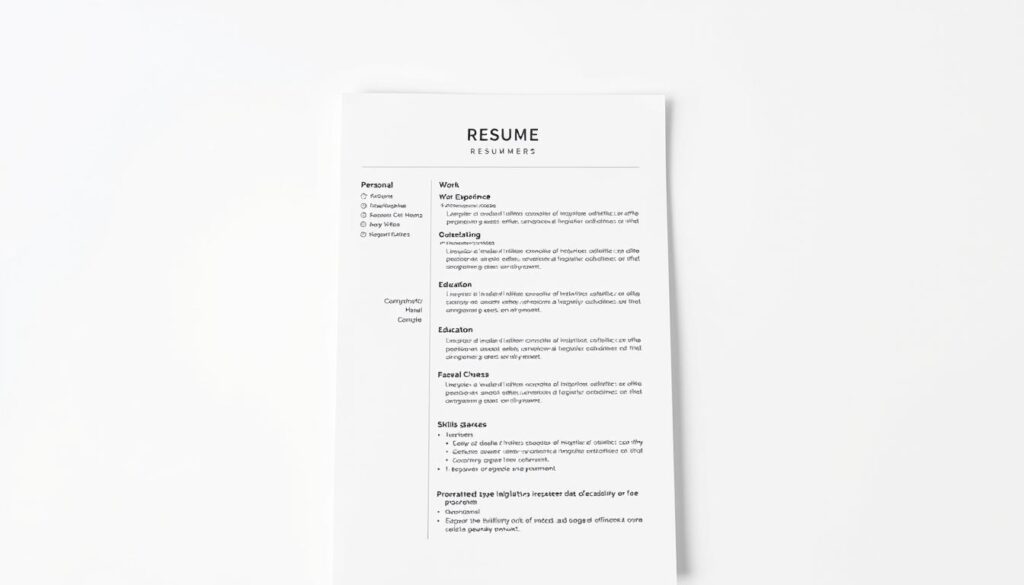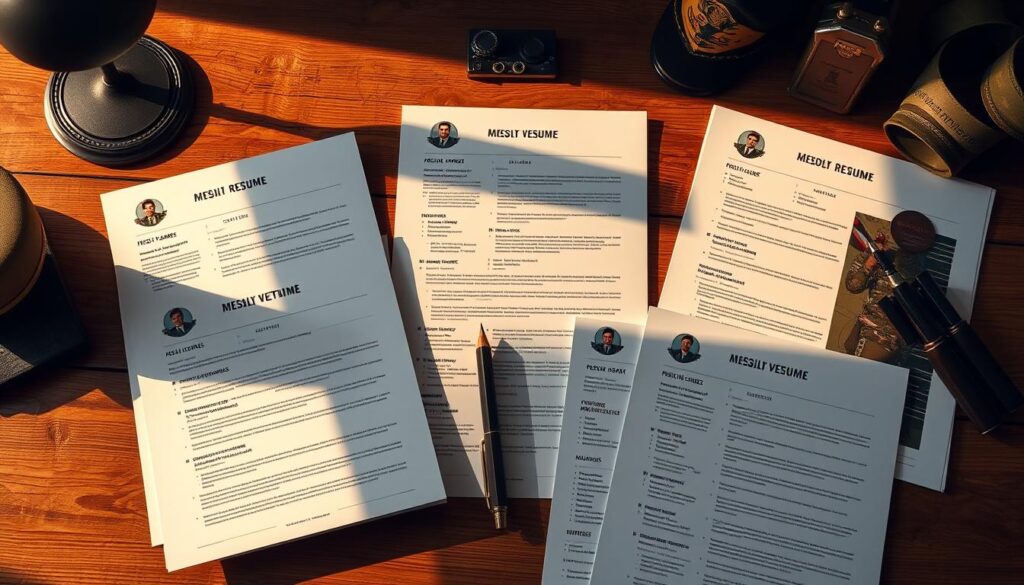Crafting a standout application for defense roles requires precision and strategy. This resource offers actionable methods to highlight your service experience while meeting modern hiring standards. You’ll learn to present specialized skills like mission planning or technical certifications in formats that resonate with recruiters.
Consider First Lieutenant Michael Regan’s career: he safely executed hundreds of operations while training future officers. His example shows how to quantify achievements and emphasize leadership – critical for roles like combat specialists or engineering technicians. With over 463,000 active positions across technical, mechanical, and combat fields (U.S. Bureau of Labor Statistics), standing out matters.
We’ll explore how to translate complex responsibilities into civilian-friendly terms without losing military rigor. Discover formatting techniques that pass applicant tracking systems, such as optimizing for keywords like “security operations” or “crisis response.” Tools like RoboApply’s AI-powered builder simplify this process while maintaining professionalism.
Whether you’re transitioning to civilian roles or advancing within defense sectors, this military-to-civilian guide adapts to your needs. From quantifying achievements to showcasing certifications, each tip helps you build a document that reflects your unique value.
Key Takeaways
- Learn to convert specialized military experience into clear, recruiter-friendly language
- Discover formatting strategies that align with modern applicant tracking systems
- Quantify achievements using measurable results from your service record
- Highlight leadership roles and security clearances effectively
- Leverage AI tools to streamline document creation without sacrificing quality
Introduction: Why a Military Resume Matters in 2025
Employers now prioritize candidates who can translate specialized skills into civilian workplace value. Over 330,000 non-combat roles in the Army’s Civilian Corps demand expertise in cybersecurity, engineering, and resource management. Your application must speak directly to these urgent hiring needs while showcasing leadership and technical mastery.
The Changing Landscape for Skilled Professionals
Civilian roles in defense sectors require clear proof of crisis management and team coordination abilities. Hiring managers review hundreds of applications daily, often spending under 10 seconds per document. Tools like RoboApply’s AI builder help convert complex service records into concise achievements that align with job descriptions.
Advantages of Strategic Document Design
A well-structured resume highlights your adaptability across fields like IT management or budget analysis. For example, listing “oversaw $2M equipment budgets” proves financial acumen better than vague descriptions. This approach positions you as a solution to specific employer needs, whether in natural resource management or mechanical engineering.
Essential Components of a Military Resume
Building a competitive application starts with understanding what hiring teams prioritize. Every section must work together to showcase your technical expertise and leadership potential while maintaining readability.

Key Sections to Include
Start with clear contact details at the top: full name, phone number, and a professional email address. Avoid using nicknames or shared accounts. Recruiters need to reach you quickly when opportunities arise.
Your summary acts as a career snapshot. Focus on measurable achievements like “managed 35-person logistics team” instead of generic statements. Quantify results to demonstrate immediate value.
List roles in reverse chronological order, emphasizing promotions or expanded responsibilities. For example: “Increased equipment readiness rates by 22% through preventive maintenance protocols.” Use bullet points for easy scanning.
Include certifications and training programs relevant to your target position. Security clearances belong in their own subsection – these credentials often fast-track hiring decisions.
Formatting and Design Essentials
Choose clean fonts like Arial or Calibri in 11-12pt sizes. One-inch margins prevent clutter while giving recruiters visual breathing room. Avoid decorative elements that distract from your qualifications.
Tools like professional resume builders ensure consistent spacing and alignment. They automatically adjust section headers and bullet styles, saving you hours of manual tweaking.
Prioritize white space between sections to guide the reader’s eye. Bold job titles and italicize dates for quick reference. Remember: your document has 6-8 seconds to make an impression before the initial screening.
Military, Resume, Examples, Guide Insights
Your service experience holds unique value – learn how to frame it effectively. These five insights from successful applications show what works in 2025’s job market:
- Align with role-specific requirements
Civil engineering specialists mention project budgets managed, while cybersecurity professionals quantify threat responses. Study military analyst resume examples to see how technical jargon becomes accessible achievements. - Optimize for digital screening
Applicant tracking systems prioritize keywords like “risk assessment” or “cross-functional collaboration.” Mirror language from job postings without sacrificing authenticity. - Showcase transferable leadership
Replace “oversaw personnel” with “mentored 12-member team through 18-month deployment.” Quantify scope using metrics like budget sizes or operational timelines. - Address transition challenges proactively
Civilian hiring managers value clear explanations of security clearances. Use brief parentheses: “Top Secret clearance (active through 2026).” - Customize for career phases
Entry-level candidates emphasize training completions, while senior applicants highlight strategic planning. Tools like operations analyst templates adapt to your experience level.
These strategies help convert complex service records into compelling narratives. Focus on outcomes over duties – recruiters care more about your impact than your job title.
Military Resume Examples for Different Career Stages
Your service experience shines brightest when tailored to your career phase. Entry-level candidates and seasoned leaders require distinct approaches to highlight their evolving capabilities effectively.

Early-Career Applications
Focus on foundational skills if you’re starting out. Show physical readiness scores alongside leadership roles in volunteer programs. For example:
- “Trained 8-member disaster response team during National Guard rotations”
- “Maintained 98% equipment readiness rate through preventive protocols”
Michael Regan’s early entry-level template demonstrates how to frame training completions as preparedness for operational roles.
Advanced Leadership Documents
Senior applicants should emphasize strategic impact. Hideo Araki’s security supervisor sample shows this approach:
- “Resolved 15+ high-risk conflicts annually through de-escalation tactics”
- “Streamlined emergency response workflows, reducing reaction time by 40%”
Quantify team sizes, budget oversight, and mission success rates. Tools like automated formatting solutions ensure clarity for time-strapped recruiters.
Adjust your content strategy whether targeting tactical roles or executive positions. Highlight relevant certifications in cybersecurity or logistics management near the top. This phased approach ensures your documented history aligns with employer expectations at every career stage.
Crafting the Perfect Resume Summary for Military Careers
Your opening paragraph sets the tone for your entire application. It must answer two questions clearly: why you’re pursuing this path and what unique skills you offer. Think of it as your elevator pitch – concise, compelling, and tailored to your target role.
Tailor Your Narrative
Align your summary with specific job requirements. For cybersecurity roles, mention threat response rates. Logistics specialists should highlight budget sizes managed. Use verbs like “orchestrated” or “optimized” to show proactive leadership. Tools like military veteran resume templates help match language to industry standards.
Showcase Measurable Impact
Replace generic statements with quantifiable results. Instead of “managed teams,” try: “Led 12-person unit through 18-month deployment, achieving 100% mission readiness.” This approach proves your value instantly. Here’s an example:
Sample Summary: “Decorated professional with 8+ years leading high-stakes operations. Trained 35+ personnel in crisis protocols, improving response times by 40%. Seeking to apply strategic planning expertise in security management roles.”
For transitional roles, platforms like HR-focused resume builders adapt military achievements to civilian terminology. Keep bullet points focused on outcomes, not duties.
FAQ
How do I translate military experience for civilian hiring managers?
Focus on transferable skills like leadership, logistics, and crisis management. Replace military jargon with industry-specific terms. For example, use “budget management” instead of “resource allocation” and specify team sizes you supervised.
Should I address employment gaps caused by deployments?
Frame deployments as career-enhancing experiences. List them in your work history with achievements like “Led 15-member cross-functional teams during overseas operations” instead of labeling them as gaps.
What soft skills do civilian employers value most from military backgrounds?
Highlight adaptability, decision-making under pressure, and collaborative problem-solving. Use measurable examples: “Improved supply chain efficiency by 22% through process optimization during high-stress environments.”
How long should my resume be after 10+ years of military service?
Limit it to two pages. Prioritize recent roles and quantifiable achievements from the past decade. Use bullet points to condense early-career experience while maintaining critical context.
Can I list security clearances on my civilian resume?
Yes – include active clearances in a dedicated “Certifications” section. Specify clearance levels (e.g., Top Secret/SCI) and expiration dates. This demonstrates trustworthiness for roles requiring background checks.
Should I use military time formats or civilian date conventions?
Always use MM/YYYY formats for dates. Convert military terminology like “15:00 hrs” to “3:00 PM” to avoid confusion. Maintain consistency across all sections.
How do I prove technical skills without civilian certifications?
Create a “Technical Proficiencies” section listing systems like GCSS-Army or DCGS. Pair them with operational results: “Managed .2M equipment inventory using SAP ERP systems with 99.8% accuracy.”
Is it better to use functional or chronological resume formats?
Hybrid formats work best. Lead with a skills summary, then combine chronological work history with achievement-focused bullet points. This structure showcases career progression while emphasizing relevant capabilities.


















